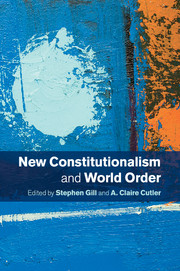Book contents
- Frontmatter
- Contents
- List of Figures
- List of Contributors
- Acknowledgements
- List of Acronyms
- 1 New constitutionalism and world order
- Part I Concepts
- Part II Genealogy, origins and world order
- Part III Multilevel governance and neo-liberalization
- Part IV Trade, investment and taxation
- 10 How to govern differently
- 11 Trade agreements, the new constitutionalism and public services
- 12 New constitutionalism, international taxation and crisis
- Part V Social reproduction, welfare and ecology
- Part VI Globalization from below and prospects for a just new constitutionalism
- Glossary
- Appendix
- Bibliography
- Index
10 - How to govern differently
Neo-liberalism, new constitutionalism and international investment law
from Part IV - Trade, investment and taxation
Published online by Cambridge University Press: 05 February 2014
- Frontmatter
- Contents
- List of Figures
- List of Contributors
- Acknowledgements
- List of Acronyms
- 1 New constitutionalism and world order
- Part I Concepts
- Part II Genealogy, origins and world order
- Part III Multilevel governance and neo-liberalization
- Part IV Trade, investment and taxation
- 10 How to govern differently
- 11 Trade agreements, the new constitutionalism and public services
- 12 New constitutionalism, international taxation and crisis
- Part V Social reproduction, welfare and ecology
- Part VI Globalization from below and prospects for a just new constitutionalism
- Glossary
- Appendix
- Bibliography
- Index
Summary
Neo-liberalism has evinced an impressive ability to structure political possibilities and constrain the discursive space for political alternatives on a global scale. This is not only a truly impressive cultural and political achievement, but also an important institutional one. As the neo-liberal imaginary has been internalized, it has turned ‘into other things’, namely, ‘neo-liberal political economy, new practices of various sorts, new identities, new material realities’ (Fairclough 2006: 30). These achievements include the institutions and practices associated with the new constitutionalism. The continuing power of neo-liberalism to structure a ‘universal common sense’ (Bourdieu and Wacquant 2005), even in the face of an ongoing global recession, bespeaks of a discursive and institutional vigour that is difficult to overcome.
But neo-liberal agents could not have secured this kind of supremacy without the ongoing complicity of states. Institutionalizing neo-liberalism requires a great deal of ‘work by a large number of distinct institutions … and thereby partly shapes the actual work of states’ (Sassen 2008: 232). State actors, indeed, have been energetically working to maintain neo-liberalism’s supremacy. Much of this is achieved through the vehicle of legal reform. For a couple of decades, the United Nations Conference on Trade and Development (UNCTAD) has been tracking national regulatory changes having an impact on the entry and establishment of foreign investment. Taking the ten-year period 2000–10, there were a total of 1,944 regulatory changes introduced by 1,417 countries. This represents a vast amount of activity on the part of differing states (though a number of states will have been counted more than once). Amongst these changes, about 85 per cent had the effect of ‘liberalizing’ investment policy while only 15 per cent were investment restrictive (UNCTAD 2011). The number of restrictive changes has increased proportionately throughout the 2000s, precipitated in part by disenchantment with legal rules to promote and protect investment.
- Type
- Chapter
- Information
- New Constitutionalism and World Order , pp. 165 - 178Publisher: Cambridge University PressPrint publication year: 2014
- 3
- Cited by



